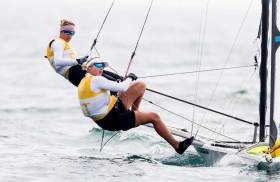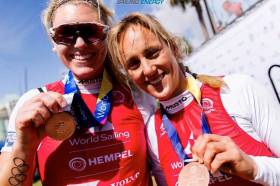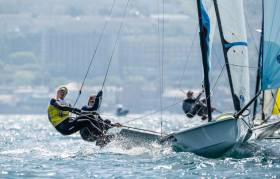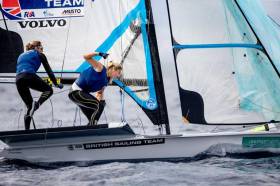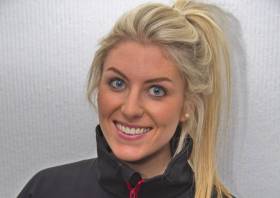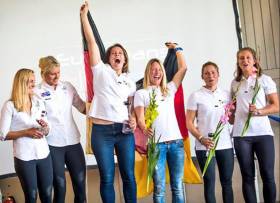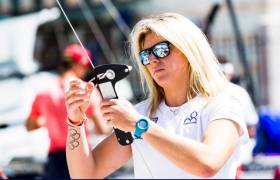Displaying items by tag: Saskia Tidey
In the 49erFX class, Great Britain’s Charlotte Dobson and Saskia Tidey from the Royal Irish Yacht Club in Dun Laoghaire have lead the 49erFX fleet since the opening race of the Ready Steady Tokyo, the official test event for the 2020 Summer Olympic Games hosted by the Japanese capital. At the midway point, the duo has built a solid 10 point lead after 9 races with only one finish outside of the top five. Brazilian superstars Martine Grael and Kahena Kunze head into the penultimate day of racing in second position and are yet to finish a race outside of the top eight.
“It was pretty hot today.” says Tidey. “The team has done a great job to help us conquer that but I must admit I went for a bit of a swim between races – intentional of course – to cool down. I’m sure everyone is feeling it out there and it’s about trying to focus and not let it take over all your thoughts.”
"If they can finish on the top of the podium in Enoshima, that could secure their Olympic berth for Great Britain"
Alex Maloney and Molly Meech from New Zealand won the day and currently sit in third position. With only a single result out of the top ten the Rio silver medallists are within striking distance of the leaders. Norway’s Helene Næss and Marie Rønningon dropped to fourth after their 1st and 5th results were not good enough to balance out two results outside of the top ten.
The leading British duo has performed intermittently at the elite level but is on the verge of peaking at just the right moment. After the 2018 Europeans and World Championships, it was their national rivals Sophie Weguelin and Sophie Ainsworth who took the bronze medal at both regattas ahead of Dobson and Tidey and looked like the leading team for the British Sailing Team’s selection to Tokyo. Ainsworth suffered an off-water knee injury just days prior to the 2019 European Championship, hindering their performance and opening the door for Dobson and Tidey to compete at Ready Steady Tokyo. If they can finish on the top of the podium in Enoshima, that could secure their Olympic berth for Great Britain.
After teething problems all the results are here. Other Irish results here
The Royal Irish Yacht Club’s Saskia Tidey and her Team GB sailing partner Charlotte Dobson have launched a crowdfunding campaign to support their efforts to qualify for the 49erFX class in next summer’s Olympic Games in Tokyo.
The pair, who finished seventh among a strong field of contender at the 49erFX Europeans last month, say they have reached a “hurdle” in their present fundraising efforts.
“The level of financial backing we have needed to maintain podium positions has now exceeded beyond what our campaign budget is capable of.”
But with additional backing, they say, “we absolutely believe we can complete and deliver the training programme we have planned to bring home a medal”.
Saskia and Charlotte have set a £5,000 of which they have raised nearly a quarter in less than a week.
For more on the pair’s campaign, see their GoFundMe page HERE.
Read the pair’s full appeal below:
We are Olympians Saskia Tidey & Charlotte Dobson. Team mates onboard our 49er FX Olympic class skiff dinghy representing Great Britain on the British Sailing team. We need your help!
After the Rio 2016 Olympic games concluded we left with fire in our bellies and our eyes and hearts set on the goal to medal at the Tokyo 2020 Olympic Games in Japan.
For three years we have battled on the International World Sailing circuit to bring home medal winning performances for Great Britain. It has been a honour to fly the flag and and a privilege to be under the pressure of striving for greatness.
Unfortunately we have reached a hurdle in our campaign which we are finding increasingly difficult to jump. The level of financial backing we have needed to maintain podium positions has now exceeded beyond what our campaign budget is capable of. With additional funds we absolutely believe we can complete and deliver the training programme we have planned to bring home a medal.
This summer we will represent Great Britain at the 2019 Olympic Test event in Japan. Please follow our journey and donate before August 2019 to help us reach the gold standard program we need to continue to succeed!
With Tokyo 2020 just around the corner we are seeking help and support from anyone would would like to join our journey and help us keep on the podium for Great Britain in 2020!
Sailing is a sport that can be overlooked and misunderstood but it is an exhilarating sport which is accessible to everyone and we would love to entice more viewers to enjoy it too!
Please help us on on our journey!
Follow our story on Instagram @gbr_44fx
Help Spread the word!
Charlotte & Saskia xox
Dun Laoghaire's Saskia Tidey of the Royal Irish Yacht Club sailing with Charlotte Dobson for Team GB finished the qualifying stages of the 49erFX Europeans in second place overall and very much in the frame for Euopean honours this weekend.
Lighter winds in Portland Harbour led to closer racing in the 49erFX fleet for day 3 of the Europeans. The top three boats all had a below-average race out of the three they contested today. The problem for the rest of the fleet is that for the Brazilians, Martine Grael and Kahena Kunze, their ‘below-average’ score was a 6th, which they are now dropping from their results. With nine races of qualifying now complete, the reigning Olympic Champions are counting four race wins, three seconds and one third place.
However, with the top 25 moving through to the gold fleet racing for the coming days, a four-point lead over the second-placed Brits, Charlotte Dobson and Saskia Tidey, really doesn’t amount to much of a buffer. Dobson had a wobble in the middle race, finishing 13th, but she can drop this from her scores. The reigning World Champions, Annemiek Bekkering and Annette Duetz, got better by the race, scoring 6,3,1 and are just one point behind the second-placed Brits.
The Dutch girls are always smiling, despite the pressure of knowing that this is a must-win regatta as the concluding part of their Olympic trials. Their closest rivals for Tokyo 2020, Odile van Aanholt and Marieke Jongens, may have been struggling in the stronger winds of Weymouth (they sit in 18th overall), but their gold medal from last month’s Hempel Sailing World Cup regatta in Genoa puts them in a strong position over the World Champions. Bekkering, while fully aware of the wider implications of success or failure in Weymouth, smiled and said simply: “We are enjoying the racing here, we’re just doing the best we can each day, and we hope to win the European Championships.”
The Olympic silver medallists, Alex Maloney and Molly Meech, had one of the best days on the water with 1,5,2 putting the Kiwis in fourth overall and still well in contention for the overall title. Then it’s a 13-point gap back to the young Swedes - Vilma Bobeck and Malin Tengstrom - who have been tearing up the track in the stronger winds, but who struggled a bit more today. “I think the other crews were still fully stretched, but we were bending the legs a bit today,” said Bobeck, one of the tallest girls in the boat park. “We’d love to have more of the big breeze, but we need to improve in the lighter winds too.” The forecast for Thursday looks like more moderate breeze for Bobeck to stretch her legs, but then it looks set to drop lighter and flukier for the weekend.
Royal Irish Yacht Club's Saskia Tidey Continues to Lead Team GB 49erFX Hopes in Palma
49erFX Skiff sailing duo Charlotte Dobson and Royal Irish Yacht Club's Saskia Tidey, of Dun Laoghaire who was a member of the Irish Sailing team for Rio but who now sails for Team GB, had a dream 2,1,1 from their first three finals races of the Trofeo Sofia in Palma yesterday to hold Rio gold medallists Martine Grael and Kahena Kunze four points astern in second.
Helm Dobson said, “In fact we had good starts and as soon as we could get clear then we were really fast. Once you get clear in gold fleet it is good. We would like just a little bit more wind to really be able to stretch but we have good confidence after the winter and have momentum after Miami. We have been using the new TruSail programme which has helped a lot. This year is about selection to start with but we figure you go out to win regattas it looks after itself.”
There'll be more competition for Dobson and Tidey when Ireland's own 49erFX campaign starts in ten days time. Olympic silver medalist Annalise Murphy and Katie Tingle hit the water at the World Cup in Genoa, Italy to make their international debut.
Full results are here Check out all our Irish Olympic sailing coverage in the build-up to Tokyo 2020 here
Team GB's Charlotte Dobson sailing with Royal Irish Yacht Club crew Saskia Tidey of Dun Laoghaire has a share of the top place along with Australia’s Natasha Bryant and Annie Wilmot after the first day of competition at the Trofeo Princesa Sofia in Palma yesterday.
With the 2020 Olympic regatta just over 15 months away this event figures highly in selections for the Olympic test event. After medalling in Miami, Dobson and Tidey will have this front of mind through the event, just as the closely matched British 49er pairs will be among the many, many teams looking to make a firm statement on the Bay of Palma.
Tidey said, “There's a huge fleet of FXs here and it's going to be a big week. We're really happy with the solid day that we had. We couldn't have asked for any more. It sets us off on the right foot and it's a good position to build on.”
As regular Afloat.ie readers will recall, Dublin Bay based Tidey opted to sail for Team GB in 2017 due to the lack of opportunities for her to further her FX career after Rio.
Since then, of course, Rio Silver medalist in the Laser Radial, Annalise Murphy announced a 49erFX campaign last year and in an exciting prospect this month, the Irish sailing superstar is to make her international debut with Katie Tingle in the class at the World Cup in Genoa, Italy in 12 days time.
Results are here Read more about Irish hopes for Tokyo 2020 here.
Sailors of the Year in 49er Action in Vilamoura, Royal Irish's Saskia Tidey Third in 49erFX
Just crowned Irish Sailors of the Year, Robert Dickson and Robert Waddilove were back on the water in Portugal finishing 23rd in a fleet of 53 at the second round of the Portugal Grand Prix in Vilamoura. Top Irish 49er duo Ryan Seaton and Seafra Guilfoyle (who injured his leg in November) were 17th and National Yacht Club duo Tadhg and Donnelly finished 31st in the 11–race regatta.
But the best result of an Irish sailor was scored by Royal Irish Yacht Club sailor Saskia Tidey – now sailing for Team GB – who finished third overall in the 49erFX fleet.
Vilamoura has been growing as a winter destination for the past few seasons. Regattas in December and now February attracted 109 and then 116 boats respectively across 49er, 49erFX, and Nacra 17. Indeed, Annalise Murphy and Katie Tingle are also based here but although out on the water at the weekend, the pair were not recorded as an entry in the official results. See full results here. See vid of the pair in Vilamoura below:
The regatta this past weekend featured big breeze and waves each of the days.
Check out this video of 2018 European Champions Helene Naess and Marie Ronningen (NOR) in absolute survival mode heading downwind as they navigate a growing graveyard.
The 49er fleet was the largest and deepest. Diego Botin and Iago Marra (ESP) hardly made any mistakes in the tough conditions, and had only one race outside of the top 10 to compliment three race wins to take the overall victory. They were pressed hard by James Peters and Fynn Sterritt (GBR) who was the only team to stay in the hunt with the Spaniards. Both teams had disappointing conclusions to the Miami World Cup only 10 days ago, being over early in the medal race, but rebounded in the much fresher conditions.
The 49er fleet was somewhat depleted by the number of teams participating in Sail GP, which overlapped, and a very healthy down under circuit in both Auckland and Australia.
The 49erFX racing was a three way battle royale for the win. Going into the final race it was the 2018 World Champions, Bekkering and Duetz (NED), on 13 points, Dobson and Tidey (GBR) on 14 points, and Nielsen and Olsen (DEN) on 20 points.
The Danish multiple European Champions, took the final race, their second in a row to keep the pressure on, but it was the 2018 World Champions from the Netherlands who managed a second in the race to claim the title. Dobson and Tidey finished in 8th, and subsequently had to be satisfied with third overall after leading for much of the regatta.
See full results here
Bronze Medal For Ex-Irish Olympian Saskia Tidey In Miami 49erFX Final
Former Irish Olympian Saskia Tidey won bronze in the 49erFX with her sailing partner Charlotte Dobson at the Hempel World Cup Series Miami yesterday (Saturday 2 February).
The Royal Irish Yacht Club skiff sailor, who switched to Team GB two years ago for her Tokyo 2020 campaign, had an impressive week on the waters of Biscayne Bay with Dobson — including three top-three placements.
The pair capped it off with a finish in fourth in the medal race that was enough to earn them the final spot on the podium behind New Zealand's Alexandra Maloney and Molly Meech who took silver, and Brazilian Olympic champions Martine Soffiatti Grael and Kahena Kunze who claimed the gold.
Also in Miami, and despite his neck injury, Ireland’s top Laser sail Finn Lynch remains in contention for a podium finish on the final day of racing later today (Sunday 3 February).
Sailing for Ireland in Rio but switching to Team GB for Tokyo, Dun Laoghaire sailor Saskia Tidey has notched up a string of top results in her firstseason with scottish helmswoman Charlotte Dobson. Last week the Royal Irish Yacht Club sailor finished second overall at the 49erfx European Championships in Kiel, Germany.
In June, Tidey took Gold at the same venue in Kiel Week, and a fortnight earlier was a Silver Medalist at the World Sailing Cup Fnals in Santander, Spain. In April, she won bronze at the Hyeres Sailing World Cup in France earning her an Afloat.ie Sailor of the Month award in to the bargain.
Listen into Dobson talking about the 2020 campaign and her new crew below.
Royal Irish Sailor Saskia Tidey's Sailing World Cup Medal Race Live (10.50 Irish Time)
Dun Laoghaire 49erFX sailor Saskia Tidey who joined Team GB after the Rio Olympics races in this morning's Sailing World Cup Final Medal Races in Santander, Spain. The GB crew lie second overall after this week's fleet racing concluded as Afloat.ie reported yesterday here.
The deciding race for Tidey and partner Charlotte Dobson will be streamed live via YouTube below at 10.50 (Irish Time) below:
Medal Race schedule in local time (Spain is one hour ahead).
11:00 – Show start
11:10 – Nacra 17
11:50 – 49er
12:30 – 49erFX
13:10 – RS:X Men
13:50 – RS:X Women
14:28 – Kiteboarding x 3 races
Lynch Gets Penalty in Mens Laser, Saskia Tidey Leads in Sailing World Cup Final in Santander
The National Yacht Club's mens Laser dinghy ace, Finn Lynch was hit with a U Flag penalty today that keeps him 23rd of 25 at the end of the second day of World Cup Final racing in Santander, Spain. Royal Irish Yacht Club sailor Saskia Tidey, also from Dun Laoghaire, but now sailing for Team GB, leads the 49erFX fleet after six races sailed with partner Charlotte Dobson. Results are here.
Santander was baked in sunshine for the second day of World Cup racing as sailors looked to either capitalise on a great opening day, or play catch up after slow starts.
Conditions were near on perfect for the 260 sailors from 41 nations racing across the ten Olympic fleets and Open Kiteboarding. Not a cloud in the sky and 11-15 knots of breeze coming from the north east enabled a full on day of racing.
 Team GB's Charlotte Dobson with Dun Laoghaire crew Saskia Tidey lead in Santander. Photo: Jesus Renedo/World Sailing
Team GB's Charlotte Dobson with Dun Laoghaire crew Saskia Tidey lead in Santander. Photo: Jesus Renedo/World Sailing
Sailors who had slow starts yesterday (6 June) used the day to make amends for any mistakes and climb the leaderboard. The overnight leaders, meanwhile, looked to maintain their focus and keep hold of the top spots.
Germany's Philipp Buhl was full of smiles ashore after racing following a consistent performance in the Men's One Person Dinghy, Laser.
Buhl grabbed a third and a fifth to move up into third place and fully in contention. As he de-rigged his Laser after racing, he was in a buoyant mood, "It was a really nice day,” he commented. "My results are good and the conditions are perfect. I cannot remember a time when I've ever come back with a big smile like today, lots of sunshine and waves made it perfect.”
The Laser fleet in Santander is full of leading competitors. Two-time World Champion Nick Thompson (GBR), Olympic medallists Tonci Stipanovic (CRO) and Pavlos Kontides (CYP) are just two of the leading lights.
Grabbing a spot at the front of the fleet is no easy task as Buhl continued, "Races like today are always hard because you must hike and everything is quite exhausting. There are a few leading guys here and you must stick and fight for the metres to come first, second or third.”
France's Jean Baptiste Bernaz holds on to his overnight lead after he picked up his second race win of the week and a third. Charlie Buckingham (USA) sits inbetween Bernaz and Buhl.
The day belonged to Evi van Acker (BEL) and Anne-Marie Rindom (DEN) in the Women's One Person Dinghy, Laser Radial as they shared the top two places in both races.
Rindom snapped up the opening victory with van Acker following. The positions were reversed in the preceding race and the pair have moved to the top of the leaderboard. Van Acker, London 2012 bronze medallist, leads on four points and Rindom, Rio 2016 bronze medallist, follows on seven.
American World Cup winner Vasileia Karachaliou (GRE) follows in third.
Spain's Fernando Echavarri and Tara Pacheco were on form in the Mixed Multihull, Nacra 17, winning two races and claiming a second. Echavarri and Pacheco know Santander very well and have spent many hours training and racing on the waters. So when the pair saw the forecast they knew what had to be done, "Today we could not afford any mistakes. The weather is very typical of Santander so it was an easy day to read the conditions.
"The key point today was to have a good start and have good speed. That is it.”
They dominated the first two races and were unlucky not to claim a third. Echvarri concluded, "In the third race we had some problems but we managed to recover from it and we almost took first place. There is still a long way to go but we are happy to know we are performing well. As I like to say, we're taking it step by step.”
Tom Phipps and Nicola Boniface (GBR) and Ruggero Tita and Caterina Marianna Banti (ITA) occupy the final podium spots after six races.
Defending World Cup Final Champion Oliver Bridge (GBR) found his form on the second day of competition, winning five out of six races in the blue fleet to leap into the podium positions. Sitting in third, he is two points off brother Guy. Nico Parlier (FRA) maintained his excellent form and snapped up five wins in the yellow fleet to extend his lead.
Rio 2016 Olympic gold medallist Hannah Mills sailing with Eilidh McIntyre (GBR) stole the show in the Women's Two Person Dinghy, 470. Mills, who has been sailing in the 49erFX recently, has made a temporary switch back to the 470 and had no trouble finding her feet on the second day of competition. The British pair claimed a pair of race wins and lead Afrodite Zegers and Anneloes van Veen (NED) who have not lost a regatta in 2017.
It's the early stages of the competition with six fleet races and a Medal Race to go so Zegers and van Veen will remain focused on continuing their run.
Olympic bronze medallists Panagiotis Mantis and Pavlos Kagialis (GRE) were on fire in the men's fleet, winning both of their races. They advance to first overall and have put five points between themselves and David Bargehr and Lukas Mahr (AUT) who are second.
A pair of second place finishes was enough for Great Britain's Ed Wright to grab the lead in the Finn, the Heavyweight One Person Dinghy. He leads race four winner Zsombor Berecz (HUN) by three points. Anders Pedersen of Norway won the opening race of the day and occupies seventh.
In the Men's and Women's Windsurfer, RS:X, two sailors in both fleets dominated the day.
Kiran Badloe (NED) swept the field aside in the men's division, winning every single race to grab the overall lead, two points ahead of Shahar Zubari (ISR). Meanwhile, Patricia Freitas (BRA) snapped up a pair of wins and a third in the women's fleet. Her advantage stands at six points over China's Yunxiu Lu, winner of the American World Cup.
Lukasz Przybytek and Pawel Kolodzinski (POL) hold onto their advantage in the Men's Skiff, 49er. A steady string of races gives them a one point advantage over James Peters and Fynn Sterritt (GBR). Dylan Fletcher and Stu Bithell (GBR) were the standout racers in the 49er, grabbing a pair of race wins and a third to move into third spot overall, within sight of the leaders.
There is still very little separation in the 49erFX, Women's Skiff, with eight points splitting the top six. Charlotte Dobson and Saskia Tidey (GBR) are in pole position following a 3-2-1 day.
Racing resumes at 12:00 local time on Thursday 8 June. The week of racing will culminate in the Live Medal Races on Saturday 10 and Sunday 11 June.



























